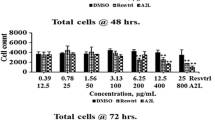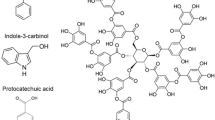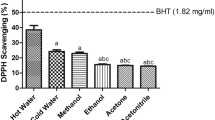Summary
Background
Dietary polyphenols like quercetin and rutin are considered beneficial because of their potential protective role in the pathogenesis of multiple diseases associated to oxidative stress such as cancer, coronary heart disease and atherosclerosis. However, many of these effects may depend on the concentration of the polyphenol utilized since high doses of some phenolic compounds may be prooxidant and negatively affect cell growth and viability.
Aim of the study
To test the potential chemoprotective effects of quercetin and rutin, two flavonols with high antioxidant capacity, on cell growth, viability and the response of the antioxidant defense system of a human hepatoma cell line (HepG2).
Methods
Cell growth was measured by diaminobenzoic acid and bromodeoxyuridine assays, cell toxicity by lactate dehydrogenase leakage assay, reduced glutathione was quantified by a fluorimetric assay, cellular malondialdehyde was analyzed by high–performance liquid chromatography, reactive oxygen species were quantified by the dichlorofluorescein assay, antioxidant enzyme activities were determined by spectrophotometric analysis and their gene expression by northern blot.
Results
Short-term exposure (4 h) to these flavonols had no antiproliferative nor cytotoxic effect. High doses of quercetin (50–100 µM) increased glutathione concentration and gene expression of Cu/Zn superoxide dismutase and catalase inhibiting the activity of the latter enzyme, whereas lower doses (0.1–1 µM) decreased gene expression of Cu/Zn superoxide dismutase and increased that of glutathione peroxidase. All doses of quercetin and rutin diminished reactive oxygen species and high doses (10–100 µM) decreased malondialdehyde concentration.
Conclusion
The results indicate that both natural antioxidants induce favorable changes in the antioxidant defense system of cultured HepG2 that prevent or delay conditions which favor cellular oxidative stress.
Similar content being viewed by others
References
Bravo L (1998) Polyphenols: chemistry, dietary sources, metabolism and nutritional significance. Nutr Rev 56:317–333
Hertog MGL, Holland PCH (1996) Potential health effects of the dietary flavonol quercetin. Eur J Clin Nutr 50:63–71
Aherne SA, O’Brien NM (1999) The flavonoids, myricetin, quercetin and rutin, protect against cholestan-3β:5α:6β-triol – induced toxicity in Chinese hamster ovary cells in vitro. Nutr Res 19:749–760
Middelton E (1996) Biological properties of plant flavonoids: an overview. Int J Pharmacol 34:344–348
Mora A, Paya M, Rios JL, Alcaraz MJ (1990) Structure activity relationship of polymethoxyflavones and other flavonoids as inhibitors of non-enzymatic lipid peroxidation. Biochem Pharmacol 40:793–797
Hertog MGL, Kromhout D, Aravanis C, Blackburn H, Buzina R, Fidanza F, Giampaoli S, Jansen A, Menotti A, Nedeljkovic S, Pekkarinen M, Simic BS, Toshima H, Feskens EJM, Hollman PCH, Katan MB (1995) Flavonoid intake and long term risk of coronary heart disease and cancer in the seven countries study. Arch Intern Med 155:381–386
Cook NC, Samman S (1996) Flavonoids – chemistry, metabolism, cardioprotective effects and dietary sources. J Nutr Biochem 7:66–76
Lapidot T, Walker MD, Kanner J (2002) Can apple antioxidants inhibit tumor cell proliferation? Generation of H2O2 during interaction of phenolic compounds with cell culture media. J Agric Food Chem 50:3156–3160
Narayanan VS, Fitch CA, Levenson CW (2001) Tumor suppressor protein p53 mRNA and subcellular localization are altered by changes in cellular copper in human Hep G2 cells. J Nutr 131: 1427–1432
Aden DP, Fogel A, Plotkin S, Damjanov I, Knowles BB (1979) Controlled synthesis of HBsAg in a differentiated human liver carcinoma-derived cell line. Nature 286:615–616
Hinegardner RT (1971) An improved fluorometric assay for DNA. Anal Biochem 39:197–201
Vasault A (1987) Lactate dehydrogenase. UV-method with pyruvate and NADH. In: Bergmeyer HV (ed) Methods of enzymatic analysis. Weinheim: Verlag-Chemie, pp 118–133
Welder AA, Acosta D (1994) Enzyme leakage as an indicator of cytotoxicity in culture cells. In: Tyson CA, Franzier JM (eds) In vitro toxicity indicators: methods in toxicology. New York: Academic press, pp 46–49
Hissin PJ, Hilf R (1976) A fluorometric method for determination of oxidised and reduced glutathione in tissues. Anal Biochem 74:214–226
Mateos R, Goya L, Bravo L (2004) Determination of malondialdehyde (MDA) by high-performance liquid chromatography as the 2,4-dinitrophenylhydrazine derivative. A marker for oxidative stress in cell cultures of human hepatoma HepG2. J Chrom B 805:33–39
Wang H, Joseph JA (1999) Quantifying cellular oxidative stress by dichlorofluorescein assay using microplate reader. Free Rad Biol Med 27:612–616
Aebi H (1987) Catalase. In: Bergmeyer HV (ed) Methods of enzymatic analysis. Weinheim: Verlag-Chemie, pp 273–282
Goldberg DM, Spooner RJ (1987) Glutathione reductase. In: Bergmeyer HV (ed) Methods of enzymatic analysis. Weinheim: Verlag-Chemie, pp 258–265
Gunzler WA, Kramers H, Flohe L (1974) An improved coupled test procedure for glutathione peroxidase. Klin Chem Klin Biochem 12:444
Bradford MM (1976) A rapid and sensitive method for the quantification of microgram quantities of protein, utilizing the principle of protein-dye binding. Anal Biochem 72:248
Lipkin M, Reddy B, Newmark H, Lamprecht SA (1999) Dietary factors in human colorectal cancer. Annu Rev Nutr 19:545–586
Duthie GG, Duthie SJ, Kyle JAM (2000) Plant polyphenols in cancer and heart disease: implications as nutritional antioxidants. Nutr Res Rev 13:79–106
Agullo G, Gamet L, Besson C, Demigne C, Remesy C (1994) Quercetin exerts a preferential cytotoxic effect on active dividing colon carcinoma HT29 and Caco-2 cells. Cancer Lett 87:55–63
Ranelletti FO, Ricci R, Larocca LM, Maggiano N, Capelli A, Scambia G, Benedetti-Panici P, Mancuso S, Rumi C, Piantelli M (1992) Growth-inhibitory effect of quercetin and presence of type-II estrogen-binding sites in human colon-cancer cell lines and primary colorectal tumors. Int J Cancer 50:486–492
Richter M, Ebermann R, Marian B (1999) Quercetin-induced apoptosis in colorectal tumor cells: possible role of EGF receptor signaling. Nutr Cancer 34:88–99
Singhal RL, Yelt YA, Praja N, Olah E, Sledge GW, Weber G (1995) Quercetin down-regulates signal transduction in human breast carcinoma cells. Biochem Biophys Res Commun 208:425–431
Duthie SJ, Johnson W, Dobson VL (1997) The effect of dietary flavonoids on DNA damage (strand breaks and oxidized pyrimidines) and growth in human cells. Mutat Res 390:141–151
Noroozi M, Angerson WJ, Lean MEJ (1998) Effects of flavonoids and vitamin C on oxidative DNA damage to human lymphocytes. Am J Clin Nutr 67:1210–1218
Scambia G, Ranelletti FO, Panici PB, Devincenzo R, Bonanno G, Ferrandina G, Piantelli M, Bussa S, Rumi C, Cianfriglia M, Mancuso S (1994) Quercetin potentiates the effect of adriamycin in a multidrug-resistant mcf-7 human breast-cancer cell-line–p-glycoprotein as a possible target. Cancer Chem Pharmacol 34:459–464
Kang TB, Liang NC (1997) Studies on the inhibitory effects of quercetin on the growth of HL-60 leukemia cells. Biochem Pharmacol 54:1013–1018
Uddin S, Choudhry MA (1995) Quercetin, a bioflavonoid, inhibits the DNA synthesis of human leukemia cells. Biochem Mol Bio Int 36:545–550
Kuo SM (1996) Antiproliferative potency of structurally distinct dietary flavonoids on human colon cancer cells. Cancer Lett 110:41–48
Chi CW, Chang YF, Ou YR, Hsieh CC, Lui YW, Peng FK, Liu TY (1997) Effect of quercetin on the in vitro and in vivo growth of mouse hepatoma cells. Oncol Res 4:1021–1024
Brusick D (1993) Genotoxicity of phenolic antioxidants. Toxicol Ind Health 9:223–230
Ahmed MS, Ramesh V, Nagaraja V, Parish JH, Hadi SM (1994) Mode of binding of quercetin to DNA. Mutagenesis 9:193–197
Viña J (1990) Glutathione: metabolism and physiological functions.CRC Press, Boston
Rodgers EH, Grant MH (1998) The effect of the flavonoids, quercetin, myricetin and epicatechin on the growth and enzyme activities of MCF7 human breast cancer cells. Chem Biol Interact 116:213–228
Myhrstad MC, Carlsen H, Nordstrom O, Blomhoff R, Moskaug JO (2002) Flavonoids increase the intracellular glutathione level by transactivation of the gamma-glutamylcysteine synthetase catalytical subunit promoter. Free Rad Biol Med 32:386–393
Scharf G, Prustomersky S, Knasmuller S, Schulte-Hermann R, Huber WW (2003) Enhancement of glutathione and g-glutamylcysteine synthetase, the rate limiting enzyme of glutathione synthesis, by chemoprotective plant-derived food and beverage components in the human hepatoma cell line HepG2. Nutr Cancer 45:74–83
Pilz J,Meineke I, Gleiter CH (2000) Measurement of free and bound malondialdehyde in plasma by high-performance liquid chromatography as the 2,4-dinitrophenylhydrazine derivative. J Chrom B 742:315–325
Suttnar J, Cermak J, Dyr E (1997) Solidphase extraction in malondialdehyde analysis. Anal Biochem 249:20–23
Suttnar J, Masova L, Dyr E (2001) Influence of citrate and EDTA anticoagulants on plasma malondialdehyde concentrations estimated by high-performance liquid chromatography. J Chrom B 751:193–197
Holley AE, Cheeseman KH (1993) Measuring free radical reactions in vivo. Br Med Bull 49:494–505
LeBel CP, Ishiropoulos H, Bondy SC (1992) Evaluation of the probe 2’,7’- dichlorofluorescein as an indicator of reactive oxygen species formation and oxidative stress. Chem Res Toxicol 5:227–231
Lores-Arnaiz S, Llesuy S, Cutrin JC, Boveris A (1995) Oxidative stress by acute acetaminophen administration in mouse liver. Free Rad Biol Med 19:303–310
Röhrdanz E, Ohler S, Tran-Thi Q-H, Kahl R (2002) The phytoestrogen Daidzein affects the antioxidant enzyme system of rat hepatoma H4IIE cells. J Nutr 132:370–375
Ursini F, Maiorino M, Brigelius-Flohé R, Aumann KD, Roveri A, Schomburg D, Flohé L (1995) Diversity of Glutathione peroxidases. Methods Enzymol 252:38–114
Nagata H, Takekoshi S, Takagi T, Honma T, Watanabe K (1999) Antioxidative action of flavonoids, quercetin and catechin, mediated by the activation of glutathione peroxidase. Tokai J Exp Clin Med 24:1–11
Breinholt V (1999) Desirable versus harmful levels of intake of flavonoids and phenolic acids. In: Kumpulainen JT, Salonen JT (eds) Natural antioxidants in nutrition, health and disease. Cambridge: Royal Society of Chemistry, pp 93–105
Park EY, Rho HM (2002) The transcriptional activation of the human copper/ zinc superoxide dismutase gene by 2,3,7,8-tetrachlorodibenzo-p-dioxin through two different regulator sites, the antioxidant responsive element and xenobiotic responsive element. Mol Cell Biochem 240:47–55
Zhou LZ, Johnson AP, Rando TA (2001) NF kappa B and AP-1 mediate transcriptional responses to oxidative stress in skeletal muscle cells. Free Rad Biol Med 31:1405–1416
Author information
Authors and Affiliations
Corresponding author
Rights and permissions
About this article
Cite this article
Alía, M., Mateos, R., Ramos, S. et al. Influence of quercetin and rutin on growth and antioxidant defense system of a human hepatoma cell line (HepG2). Eur J Nutr 45, 19–28 (2006). https://doi.org/10.1007/s00394-005-0558-7
Received:
Accepted:
Published:
Issue Date:
DOI: https://doi.org/10.1007/s00394-005-0558-7




